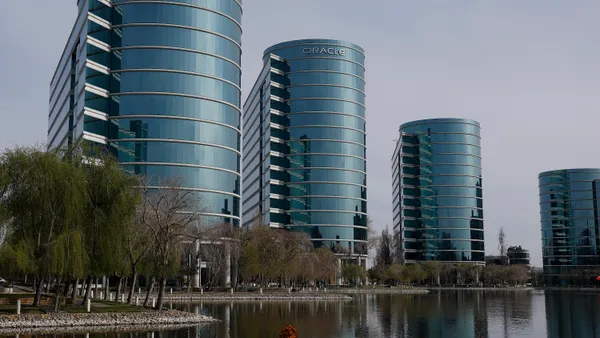Editor's note: The following article is from CIO Dive's archives. It was originally published in April 2018.
Tiger Global and Snoop Dogg lit the first match under a wave of incoming cannabis news (although perhaps just one day early) with the announcement of a $17 million investment in a cannabis software company in April 2018.
Snoop and … software? It's actually not the first time the Doggfather has invested in cannabis technology, and it may not be the last.
As of today, nine states plus the District of Columbia have legalized adult cannabis use, 29 have legalized medical use and 17 more have medical use with restrictions. More states are putting legalization on the ballot, though pushback at the federal level from Attorney General Jeff Sessions and some legislators is slowing the wave.
Cannabis funding saw a more than two-fold increase in 2017, finding footholds across operations, data and insights, digital content and compliance spaces, according to CB Insights. There are more players in the game every day, but the money pot isn't shrinking.
The industry that saw $6.7 billion in spending in 2016 is set to grow faster than a cannabis plant in an 80° F, 50% humidity greenhouse, reaching $22.6 billion by 2021 at a sustained 27% CAGR, according to Arcview Market Research. And the high growth rate is expected to continue beyond 2021 as more states build out legal adult-use markets.
Right now, the market bears a lot of similarity to the dot-com bubble of the 1990s, with new entrepreneurs and investors entering the markets, different business and pricing models emerging and a host of new companies that might make it the first mile but not the whole race, according to Jeanne Sullivan, director of capital formation at The Arcview Group, a cannabis investor network company.
But unlike the dot-com era, the cannabis industry can stave off the bust cycle and learn from the mistakes and successes of the technology industry, Sullivan said. With a market coming to fruition in the age of the cloud and artificial intelligence, business technology opportunities are ripe for the picking.
Rolling up before it's too late
Getting some skin in the game before market saturation hits may make all the difference.
Businesses which build up a loyal customer base and fill the early technology voids are amassing a home field advantage that might be just enough for when federal legalization hits. Because when that happens, big tech and big money will move from curiosity to shoulder-deep involvement, ready to light up on upon a multi-billion dollar market until it's cashed.
For example, take Baker, the "Salesforce of pot" and a CRM provider in the space. When Roger Obando, now CTO, founded the company with two other eager entrepreneurs in New York City in 2014, he saw that big spenders lacked access to the markets and consumers were being underserved.
"We realized that much like any other vice industry — the cannabis market works in the same way — there was approximately 20% of the market that was bringing in 80% of the revenue," Obando said. So Baker "backed into CRM," understanding that customer retention would be a bigger issue than customer acquisition and retailers needed a platform to establish a loyal relationship with buyers.
By staying out of transactions and focusing on SaaS, Baker was able to avoid the crosshairs of regulators and grow its business across geographic lines, cementing leadership in the market, Obando said. Larger CRM providers like Salesforce have been kept at bay by the mishmash of regulations around the country, allowing Baker, smaller players and cannabis-specific companies to stake their claim in the market.
But "big tech is waking up to what could be," Sullivan said. Just as they've done in fields like artificial intelligence and security, traditional technology leaders will come in when the space is more mature and acquire the leading entrepreneurial companies, extending the shade of their umbrella across the industry.
Many smaller players in the space are fearful of this, but the entrance of big market players could be another proxy to the dot-com era, according to Sullivan.
"When the big tech companies — Cisco and Microsoft and Facebook and Google, etc. — came in, entrepreneurism didn't go away, it thrived under the advent of all these great companies," Sullivan said. "I predict the same thing will happen."
Already the power players are coming, leaving successful careers in tech, banking and manufacturing to take up leadership roles in the cannabis industry, according to Obando. And now, with the recent recreational use legalization in California, the continent's biggest tech hub will intersect openly with the cannabis industry, driving innovation.
Is it time for Marijuana as a Service?
In most ways, the day-to-day of a CIO or CTO in the cannabis industry is similar to that of their peers in any other market.
"How do you scale a team, how do you find the right talent, how do you ensure that these [employees] aren't going to churn?" Obando asked. "How do you go from a startup mentality, where you have a monolithic application, to needing to be able to grow at scale and do microservices?"
Successfully launching any startup isn't easy, but doing so in the cannabis industry can be far more difficult. Many of the regulatory barriers across geographic lines manifest in the digital front, making the already complex jobs of the C-suite harder.
Some of the challenges Obando has encountered include:
-
A lack of access to Google AdWords or Facebook ads to promote a brand
-
Subsets of developer and other professional communities that don't want to be involved in the industry, limiting an already tight talent pool
-
Market immaturity, in which actors are readjusting to the normalization of the market — no longer looking over their shoulders — and moving from unsophisticated business models to technologies like CRM and ERP
Access to banks and providers with the resources to launch and scale a new business can also stymie entrance. Some payroll platforms are not accepting customers or clients in the cannabis industry, said Sullivan, leaving businesses to either develop a system internally or find a newer solution in the cannabis market, which may not be tried and tested enough to have all the functionalities a customer needs.
This opens the doors for business technology entrepreneurs and ancillary companies to come in, earn investor dollars and gain traction in spaces such as insurance, data analytics, seed-to-sale tracking, B2B software, UX interfaces and fintech, according to Sullivan.
With basic digital platforms taken care of, the industry can then move on to more advanced technology solutions.
With so many digital endpoints, the space is nearing a critical mass of data, paving the way for predictive analytics and artificial intelligence applications to drive actionable insights and business optimization, according to Obando.




















